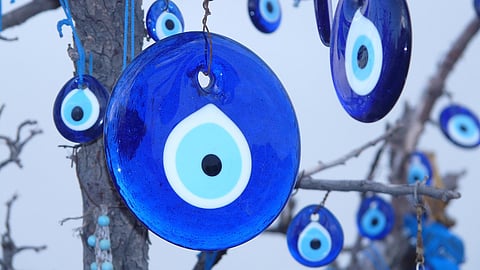
- HOME
- TRENDING
- PEOPLE
- COMMUNITY
- LIFESTYLE
- OUR PUBLICATIONSOUR PUBLICATIONS
- MASALA RECOMMENDS
- MASALAWEDS

You know that moment when you show up at a family function looking great, and someone says, "Bas, nazar na lag jaye"? It's almost a cultural reflex. Whether it's a new job, a glowing selfie, or a big achievement, the idea of the evil eye always manages to get mentioned.
But does nazar really work, and why do so many people-even celebrities-believe in it? Lets take a closer look at the beliefs, the energy theories, and what science actually says.
Many families, when they encounter unexpected setbacks or something they don't have a direct answer to, nazar becomes the quick explanation. It could be anything from a baby falling sick, something falls apart at work, love turns messy… and suddenly it’s “must be the evil eye.”
And it's not just the common people but there are also people in high-profile positions who openly talk about nazar.
Celebrities like Amrita Rao also reportedly said that her career slowed down due to nazar. Ranveer Allahbadia also pointed out that the controversy that led to his career downturn was due to being under evil-eye from getting too much attention, but not in a positive way.
These little stories keep the whole belief breathing, making nazar feel less like some old superstition and more like something people actually go through.
Because of this, people start to adopt protective habits like wearing a Nazar amulet, performing prayers and mantras and also applying a black dot on a baby’s eyes or cheek so that others won't give the baby bad nazar.
Many people believe nazar works because of how energy moves between people. When someone looks at you with envy or bad intent, the emotion they’re carrying can blend into your own energy field, or aura.
Then you somehow wonder why you feel drained, tense or slightly off around someone with negative energy. In this sense, nazar becomes less about superstition and more about how one person’s emotional state can influence another.
When explaining nazar in terms of quantum physics, one can argue that if tiny particles can react to each other instantly, even when they’re far apart, there is a possibility that strong thoughts or emotions could create small effects around us, too.
When someone looks at you with intense envy or admiration, you can often feel it like a subtle ripple in the air, because their emotional “charge” doesn’t stay with them; it spreads out and can gently shift your own mood or energy.
So, scientifically speaking, there is no real evidence to substantiate the fact that a prayer, an amulet, or a ritual creates a force field around you. Still, science may explain why doing such rituals can actually work.
Lets say you're doing a little energy cleanse, perhaps taking salt bath, burning herbs, saying a prayer, or just throwing out something that's been holding bad energy.
What's really happening is when you feel like you're doing something that has a structure and you apply meaning to it, your brain perceives it as a ritual that is keeping you safe.
So you naturally feel calmer and more in control, almost as if the ritual actually worked. You can call it something like a ritual-induced placebo.
There was this experiment where people were asked to do a simple activity. One group thought they were doing a ritual. The other group was asked to perform a random action. Same exact steps. But the group that believed it was a ritual? They felt less anxious and actually performed better.
So, it's not actually the ritual itself but the meaning behind it. Your brain latches on to that meaning, putting you in a grounded and calmer state, and that creates the feeling of being protected.